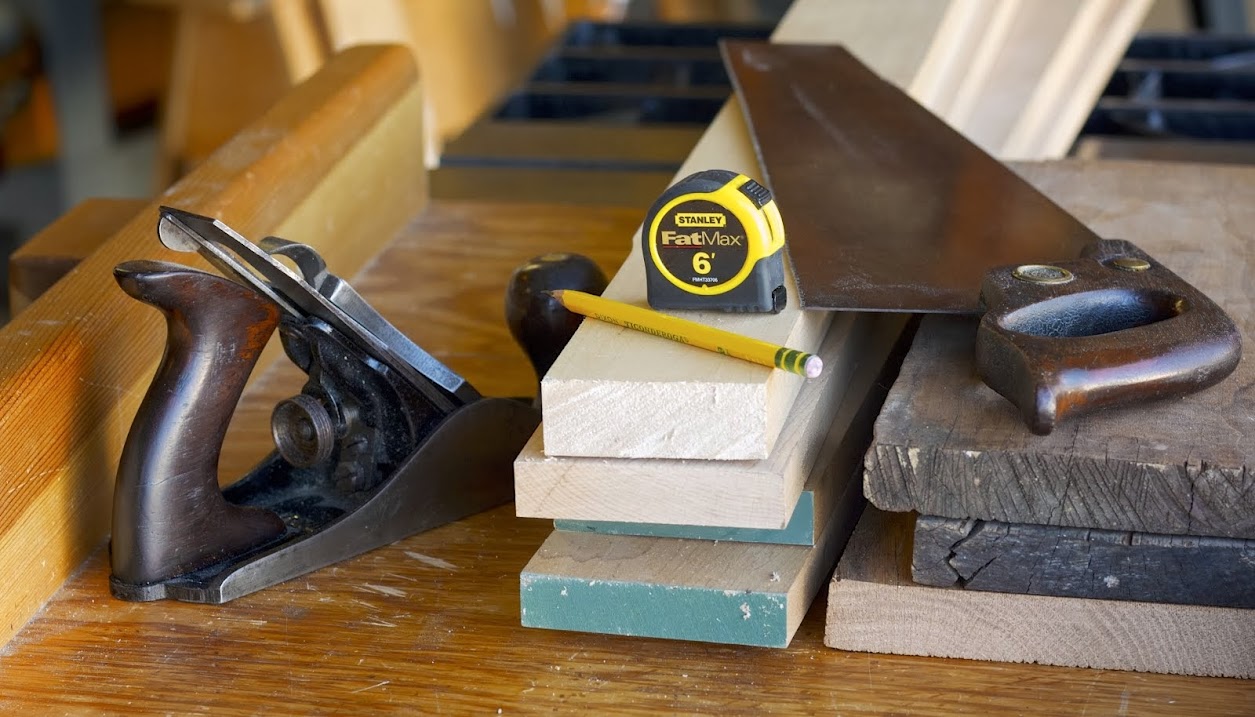Thad and his fiance, Amy, gave us a Bose SoundDock for Christmas. It's a great gift and my collection of Beatle music has never sounded better. Thad suggested that the SoundDock would be better in an open room rather than in our entertainment center, so I needed to build a small table.
I chose the clean simple design of Shaker furniture. Shaker furniture became popular in the mid nineteenth century. The Shakers and Quakers designed furniture that represented their life style. It is functional, proportional, and uses joinery such as the mortise and tenon joint without screws and nails. Danish Contemporary furniture design has similar characteristics. I made some measurements, a sketch, and headed to the garage. Luckily, I had some sugar pine on hand that could be used for the project.
 |
| Sugar Pine and Sketch |
The first step was to glue the table top together. The boards were cut into narrow widths and the growth rings at the ends were alternated. This prevents the table top from warping and cupping. The edges were planed on the jointer for a tight seamless fit. Yellow woodworker's glue and bar clamps were used to join the pieces together. The clamp pressure is the magic that causes the bond that makes the joint stronger than the wood.
 |
| Boards Glued up for Table Top |
The next step was to cut the legs, aprons, and the table top to the dimensioned sizes. The table saw was used to rip the finished widths, the power miter saw was used to cut the finished lengths, and the planer smoothed the surfaces. Because the table top was too wide to cross cut with the power miter saw, a sled setup was used on the table saw.
 |
| The Legs Planed Square |
After all the parts were cut to size, it was time to make the mortise and tenon joint. This joint is commonly used to join the table leg to the table apron. The mortise is the slot in the leg. The tenon is on the ends of the apron. The joint is very strong and requires no screws or nails.
 |
| Leg Mortises Cut Using a Straight Router Bit On the Router Table |
 |
| Apron Tenons Cut On The Table Saw |
After the mortises and tenons were cut and checked for proper fit, the legs were tapered. Shaker furniture craftsmen created an optical illusion of tapered legs by just tapering the inside faces of the legs. This makes the operation easier while creating a graceful delicate table leg. I began by laying out the taper and "rough cutting" it with the bandsaw. I left about 1/16th inch of material that was planed smooth with the jointer.
 |
| "Rough Cutting" the taper with the Band Saw. |
The edges of all the parts were rounded over with the router and each piece was sanded with 150 grit garnet sandpaper and then 180 grit. I began the assembly with the legs and table aprons. Glue was applied to the mortise and tenon joint, assembled, checked for square, and clamped.
 |
| Leg and Table Apron Assembly |
Prior to attaching the top, I applied a pre stain sealer and stain to the leg assembly and table top. I thought this would be easier and provide better coverage. I made a sample board of sugar pine to test different stains I had on hand. I chose Min-Wax Early American Stain. I like the slight reddish walnut color. It highlights the grain with a rich warm tone. After the top was attached, I applied three coats of Tung Oil for the clear finish.
 |
| Sample Stain Choices |
The final assembly step was attaching the table top to the leg assembly. There are various ways of doing this. I like to use the method shown below. Grooves were cut on the inside face of the table aprons. Small blocks were cut with a tongue that fit in the slots. The block was then fastened to the bottom of the table top. Glue was not used and the screw holes were drilled slightly larger than the screw diameter. This allows for slight natural movement of wood.
 |
| Fastening Table Top to Leg Assembly |
The table turned out great and is a nice addition to the family room. We really enjoy using the SoundDock to listen to music.
 |
| Finished Table |




















